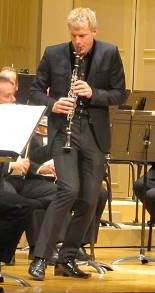
Mozart, Adams Combine for Perfect CSO Opening
The Cincinnati Symphony Orchestra opened its 2014-15
subscription season Friday night at Music Hall with a lesson. A lesson from composer John
Adams, that is. Entitled Harmonielehre,
or “Treatise on Harmony." this 1985, 40-minute work celebrates Adams’ emergence
from a compositional dry spell. Semi-autobiographical, it filled Music Hall
with the glorious sound of a full-dress symphony orchestra -- including quadruple
winds, full brass, a wealth of percussion, two harps, piano, celeste and
strings (98-strong by unofficial guestimate).

It was a CSO premiere and the kind of piece 3,500-seat Music Hall was built for.
Music director Louis Langrée planned the program for contrast, and this was achieved perfectly, with Mozart’s intimate Clarinet Concerto on the first half. Guest artist was clarinetist Martin Fröst.
Swedish-born Fröst filled Mozart’s score with exquisite beauty. He performed on a basset clarinet, a clarinet with a lower extension that is rarely used today. Mozart wrote his Concerto for Viennese clarinetist Anton Stadler, who played the basset clarinet. Fröst’s choice was a perfect fit, alleviating some of the difficulties in tone and timbre that Mozart’s Concerto poses for the regular clarinet.
The first movement unfolded after a precisely defined exposition by Langrée and the CSO. Fröst’s entrance was feather-light and he showed real substance across his range. His agility was daunting. The Adagio second movement was well-nigh miraculous in its projection. Even at Fröst’s softest, the CSO did not get in his way. His repeat of the Adagio’s opening theme was super-soft – daringly so – and he and the orchestra, attended precisely by Langrée, crafted a moment that was utterly sublime.
The rondo finale literally bubbled with good cheer, bringing the audience to its feet in an enthusiastic ovation.
For his encore, Fröst brought out his regular B-flat clarinet and took a lightning swift turn into Klezmer dances, performing “Let’s Be Happy” in a virtuosic arrangement for clarinet and orchestra by his brother Göran Fröst. The music and its effect were delightful, with smears, tip-top notes, steeple chase passagework and with an on-the-spot, improvised introduction for solo clarinet. As the audience filed out for intermission, many were shaking their heads in wonder at what they had heard.
Adams’ Harmonielehre gave them another rare experience. It is in three movements. Part I is untitled. Parts II and III are entitled “The Anfortas Wound” and “Meister Eckhardt and Quackie.”
Part I opened with hammered fortissimo repetitions of an E-minor chord, very minimalist in style, and with a pulsing, chugging beat. Gradually the furor subsided and a dark passage in the horns and cellos enveloped it. This passed to the violins in meandering fashion, then to the violas and English horn. What we heard overall was a play of colors (the movement is in the form of inverted arch). The music worked its way up again with lots of staccato figures and big statements by the brass to resolve into a big, bright outpouring, again with pounding chords.
“The Anfortas Wound” refers to the Grail King with the wound that will not heal. Adams identifies this movement with his own struggle to regain inspiration to compose, a struggle resolved by Harmonielehre itself.
After a soft opening by the double basses, the cellos intoned a solemn melody. (Adams in not in minimalist territory here, but more in tune with the late romantics.) Principal trumpeter Matthew Ernst sounded a high, earnest melody with a fearfully sad ring, which was taken over by the strings. This reached a climax, which was succeeded by a second intense, climax. Bass drum rolls and trombone blasts lent a tone of horror, which dropped off suddenly, to be followed by Elizabeth Freimuth’s keening French horn solo, as the music deflated into one last, soft breath.
Part III, “Meister Eckhardt and Quackie” is named for the German medieval mystic Meister Eckhardt and Adams’ young daughter Emily, for a time nicknamed Quackie. The vision is of Emily riding on the monk’s shoulders. After a sunny beginning with string harmonics, high woodwinds and harps, a serene violin melody ensued. Adams’ characteristic chugging rhythms returned, and the movement built ecstatically, with lots of mallet percussion. The horns entered with soaring figures high above, and the movement ended with a triumphant major chord.
The audience responded in kind, awarding Langrée and company a cheering, standing ovation. Langrée refused a solo bow, dragging concertmaster Timothy Lees to his feet instead.
The concert repeats at 8 p.m. tonight at Music Hall. Tickets begin at $12. Call (513) 381-3300, or visit www.cincinnatisymphony.org